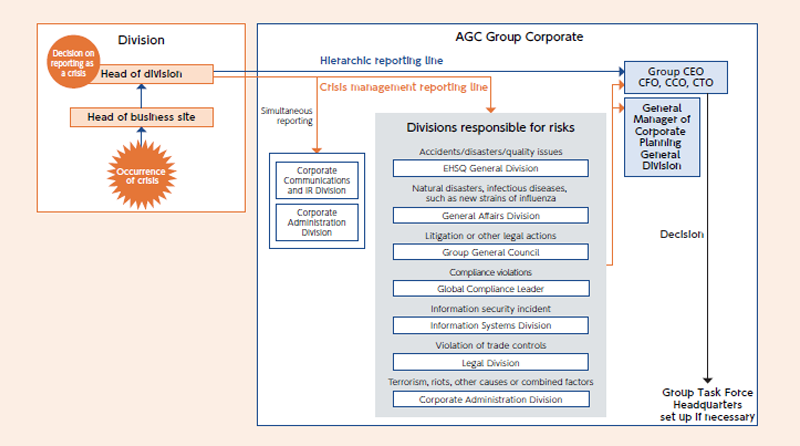Risk Management
Management Structure
The Group has established the AGC Group Enterprise Risk Management Basic Policies based on its Corporate Policy over Internal Control, the establishment of which was approved by a resolution of the Board of Directors. The Group as a whole is working on enterprise risk management based on this policy.
Among the risks that could hinder the achievement of the Group's management targets, those that require particularly intensive monitoring from the perspective of their potential impact on the Group's management and the likelihood of their occurrence are selected as major risks. The Group implements measures aimed at mitigating the materialization of such risks, and conducts annual self-assessments across the Group to continuously improve the level of risk management. For long-term sustainability risks, the AGC Group identifies major opportunities and risks that could affect the long-term direction of management and corporate value, based on future trends in global social issues and risks, as well as the social issues our customers are working to resolve, as the AGC Group's materiality. Based on this process, we have established sustainability targets aimed at leveraging opportunities and dealing with risks, and are working to resolve them. Under the supervision of the Board of Directors, the Sustainability Committee determines policies to address such long-term risks related to sustainability and deliberates on future measures based on the progress of the targets.
AGC Group Risk Classification
‣Strategy
‣Operation
‣Compliance
‣Sustainability
‣Natural disasters / Infectious diseases
‣Cybersecurity / Information security
‣Financial
Business Continuity Management and Crisis Management
The AGC Group has established a business continuity management (BCM) system to minimize the impact of crises that may have a significant effect on business activities and has set forth procedures for reporting and responding to such crises in the AGC Group Rules for Crisis Management and Business Continuity Management.
Under this system, we have established a “Crisis Management Reporting Line” to ensure prompt and reliable access to information in the event of a crisis. We have also established response procedures so that the Group Task Force Headquarters can be immediately set up as necessary to ensure a smooth crises response.
In order to respond properly to crises especially in the event of accidents or disasters, each site implements safety and disaster prevention initiatives. In addition, the AGC Group has developed a Business Continuity Plan (BCP) to ensure the continuation of operations, and strive to continuously enhance and improve its level of responsiveness to achieve recovery and restore operations in a rapid manner.
Reporting Line During a Crisis Situation

BCP Establishment and Improvement
The AGC Group, under the AGC Group Risk Management and Business Continuity Management Rules, has established four basic policies for responding to risks that significantly impact the Group's business activities. These policies are: “human life and safety first,” “prevention of secondary disasters,” “contribution to and co-existence with society,” and “business continuity.” Each business division and site develops its own BCP.
In line with these policies, we have evaluated risks relating to earthquakes, high winds, floods, etc., across our major Group sites around the world (approximately 200 locations). We have created a hazard map, which categorize the severity of hazard risks through color-coding. At sites in high-risk areas, we are advancing efforts to develop BCPs.
For earthquakes in particular, we have developed BCPs for our main high-risk sites in Japan and Asia. Additionally, every year at our headquarters, we conduct tabletop drills involving the Group CEO, division heads, and relevant key personnels, with the aim of raising awareness and improving the effectiveness of BCPs. In 2023, we conducted a drill simulating an earthquake directly under Tokyo, and held an online workshop to discuss initial responses, potential damage and our responses in each division, and cross-organization coordination when a disaster strikes.
At the AGC Group (Japan), we have been operating an employee safety confirmation system since 2009 that checks the safety of employees and their families in case of a disaster, and we conduct Group-wide safety notification drills twice a year in Japan. We also conduct response training for power outages caused by natural disasters at our business locations in Southeast Asia.
We will verify the effectiveness of our established BCPs through repeated drills while continuing to improve our BCPs.
Regarding infectious diseases, we have continued our operations through the implementation of BCP prepared by business including each site during the global spread of COVID-19 started in 2020. Even today, in preparation for the next outbreak of large-scale infectious diseases, the AGC Group has established and maintain a BCP based response system that incorporates various measures, such as remote work, to ensure human life and safety as well as to minimize the impact and continue operations in such an event.

